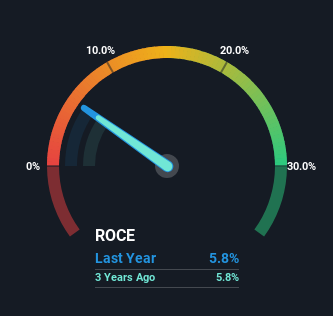- Hong Kong
- /
- Telecom Services and Carriers
- /
- SEHK:788
Returns On Capital At China Tower (HKG:788) Have Hit The Brakes

To find a multi-bagger stock, what are the underlying trends we should look for in a business? Typically, we'll want to notice a trend of growing return on capital employed (ROCE) and alongside that, an expanding base of capital employed. Basically this means that a company has profitable initiatives that it can continue to reinvest in, which is a trait of a compounding machine. In light of that, when we looked at China Tower (HKG:788) and its ROCE trend, we weren't exactly thrilled.
Understanding Return On Capital Employed (ROCE)
Just to clarify if you're unsure, ROCE is a metric for evaluating how much pre-tax income (in percentage terms) a company earns on the capital invested in its business. The formula for this calculation on China Tower is:
Return on Capital Employed = Earnings Before Interest and Tax (EBIT) ÷ (Total Assets - Current Liabilities)
0.058 = CN¥15b ÷ (CN¥318b - CN¥61b) (Based on the trailing twelve months to June 2023).
Thus, China Tower has an ROCE of 5.8%. On its own that's a low return on capital but it's in line with the industry's average returns of 5.8%.
View our latest analysis for China Tower

In the above chart we have measured China Tower's prior ROCE against its prior performance, but the future is arguably more important. If you'd like, you can check out the forecasts from the analysts covering China Tower here for free.
The Trend Of ROCE
The returns on capital haven't changed much for China Tower in recent years. Over the past five years, ROCE has remained relatively flat at around 5.8% and the business has deployed 41% more capital into its operations. Given the company has increased the amount of capital employed, it appears the investments that have been made simply don't provide a high return on capital.
On a side note, China Tower has done well to reduce current liabilities to 19% of total assets over the last five years. This can eliminate some of the risks inherent in the operations because the business has less outstanding obligations to their suppliers and or short-term creditors than they did previously.
The Key Takeaway
In summary, China Tower has simply been reinvesting capital and generating the same low rate of return as before. And in the last five years, the stock has given away 27% so the market doesn't look too hopeful on these trends strengthening any time soon. All in all, the inherent trends aren't typical of multi-baggers, so if that's what you're after, we think you might have more luck elsewhere.
If you'd like to know about the risks facing China Tower, we've discovered 1 warning sign that you should be aware of.
While China Tower may not currently earn the highest returns, we've compiled a list of companies that currently earn more than 25% return on equity. Check out this free list here.
New: AI Stock Screener & Alerts
Our new AI Stock Screener scans the market every day to uncover opportunities.
• Dividend Powerhouses (3%+ Yield)
• Undervalued Small Caps with Insider Buying
• High growth Tech and AI Companies
Or build your own from over 50 metrics.
Have feedback on this article? Concerned about the content? Get in touch with us directly. Alternatively, email editorial-team (at) simplywallst.com.
This article by Simply Wall St is general in nature. We provide commentary based on historical data and analyst forecasts only using an unbiased methodology and our articles are not intended to be financial advice. It does not constitute a recommendation to buy or sell any stock, and does not take account of your objectives, or your financial situation. We aim to bring you long-term focused analysis driven by fundamental data. Note that our analysis may not factor in the latest price-sensitive company announcements or qualitative material. Simply Wall St has no position in any stocks mentioned.
About SEHK:788
China Tower
Provides telecommunication tower infrastructure services in the People's Republic of China.
Excellent balance sheet with proven track record.

